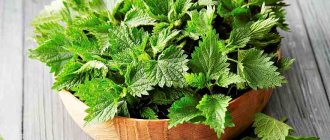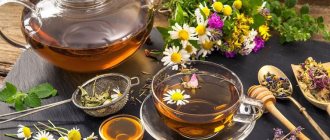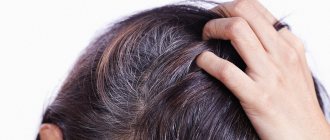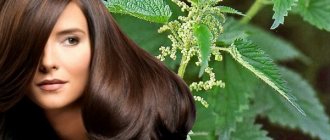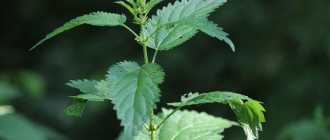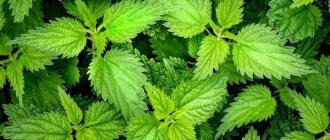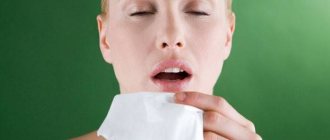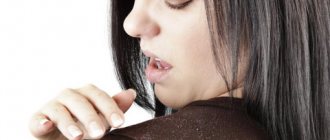In folk medicine, there are a large number of recipes for medicinal products prepared on the basis of nettle.
Existing research confirms its healing properties for the circulatory system. In particular, carp can lower blood pressure. Another study points to the effectiveness of nettle in stopping bleeding.
It is obvious that the plant has a beneficial effect on the blood. Therefore, many are interested in how nettle can affect blood viscosity. Below we will answer this question.
How does it affect blood viscosity?
Let us immediately note that there are no reliable studies on the effect of nettle on blood viscosity.
Among followers of traditional medicine, opinions vary. Some claim that the plant thins the blood, others believe the opposite.
In fact, fresh nettle can thicken the blood. The fact is that it contains a large amount of vitamin K1. It is not synthesized by the human body, so the vitamin can enter it only with a certain group of foods or medications.
It is reliably known that vitamin K1 increases blood clotting and stimulates the production of prothrombin. As a result, being rich in vitamin K1, fresh nettle:
- thickens the blood;
- increases its coagulability.
Unlike fresh nettle, vitamin K1 is almost completely absent in dry nettle. This leads to the fact that dry collection does not have any significant effect on blood viscosity.
Expert commentary
Kardash Anton Borisovich
Therapist, cardiologist. Doctor of the highest category.
Thus, fresh nettle increases blood viscosity. It is strictly forbidden to use this plant in any form together with anticoagulant drugs such as Warfarin.
The ability of the fresh plant to increase blood viscosity allows it to be used to stop various types of bleeding. The blood clotting index directly affects the rate of wound healing.
Nettle beneficial properties, application, contraindications, folk remedies.
It is very useful to consume the first shoots of herbs in the spring. Nettles are one of the first to hatch from the ground towards the sun's rays. Young nettle is a storehouse of minerals, vitamins and even protein. In addition, young shoots carry a powerful energy impulse for renewal. It’s not for nothing that people say: nettle cures seven ailments. There are several varieties of this plant. Stinging nettle (Urtica dioical) is considered the best. Stinging nettle (also called dog nettle) and stinging nettle (or non-stinging nettle) are its relatives and also have medicinal properties. Therefore, if you collected them by mistake, they will also be useful. Nettle of any kind is suitable as a good, proven folk remedy.
Whatever part of the plant you prepare: leaves, stems, flowers, roots, seeds, juice - everything is useful. It is even useful to inhale the aroma coming from the thinnest needles on the leaves and stems of nettle: they contain formic acid and histamine, which saturate the air with phytoncides.
But early nettle is most valued as an excellent source of vitamins. The snow has not yet completely melted, but timid nettle sprouts are already beginning to hatch from the ground. And they already contain vitamins: ascorbic acid (vitamin C), a whole group of vitamin B: B1 B2, B3, B5, as well as pantothenic acid, starch, tannins, protein, carotenoids (there are four of them in nettles - in addition to the well-known carotene, there is also xanthophyll , violaxanthin, xanthophiepoxide). This is truly an invaluable natural complex. Thus, vitamin C together with carotenoids have the ability to restore hearing, vision, and smell. Selenium contained in nettle rids the body of free radicals and is thus able to fight many diseases.
Micro- and macroelements included in nettle: calcium, potassium, magnesium (normalize heart function); iron, copper, manganese and zinc (increase the formation of red blood cells, increase hemoglobin and lower blood sugar). In addition to them, nettle also contains other elements of the periodic table: chromium, molybdenum, aluminum, nickel, barium, sulfur, lead. Due to the presence of chlorophyll in nettle (it contains almost 5%), this plant is indispensable in oncology.
This entire unique complex of useful substances concentrated in nettle gives it healing properties, it:
- has a diuretic effect,
- responsible for hematopoiesis
- cleanses the blood of toxins, nicotine, carcinogens, and other harmful substances
- lowers blood sugar
- normalizes the menstrual cycle
- has a tonic effect
- stimulates protein and carbohydrate metabolism
- normalizes thyroid function,
- has a wound healing effect,
- removes urate salts,
- dilutes bile,
- promotes milk formation in nursing mothers,
- reduces temperature during fever
- used to treat epilepsy
- has vasoconstrictor properties
Treatment with nettle
For immunodeficiency
People often face a deficiency of immunity, as a result of which they often get sick; in this case, nettle juice will help strengthen the body.
They drink nettle juice along with the juices of carrots, cranberries, lingonberries, and birch. To do this, dilute 1 tablespoon of the juice mixture in 50 ml of boiled or filtered water, drink 3-5 times a day.
Nettle juice, recipe
In order to prepare juice from nettles, you need to select only young, flowering shoots 30 cm or 40 cm long. Nettles need to be washed, finely chopped or minced. Then strain through cheesecloth. You can prepare juice for future use (add 200 g of vodka per 1 liter of juice). You can store nettle juice in this form for a year in a cool place (from 0 to +5°C).
For wounds that take a long time to heal
The most famous property of nettle since ancient times is its ability to heal wounds, burns and ulcers well. To do this, you need to crush the collected fresh nettle leaves and sprinkle them on ulcerated or wounded areas of the skin several times a day (usually the procedure is carried out 3 times a day), applying a light bandage on top or without it.
For bleeding
Of course, any type of bleeding requires immediate medical attention. The hemostatic effect of nettle is associated with the presence of vitamin K in the leaves, the latter has a stimulating effect on the liver and it begins to produce prothrombin, which is responsible for blood clotting. As a hemostatic agent, fresh nettle is used for: nasal, uterine, pulmonary, intestinal, hemorrhoidal bleeding. Brew fresh nettle leaves at the rate of: 100 g per half liter of boiling water and after 30 minutes you can drink the infusion 100 ml 3 to 5 times a day between meals.
But herbal preparations with nettles, with the addition of burnet, shepherd's purse, yarrow, plantain, horsetail, are more effective. Since the use of nettle infusion makes the blood more viscous, people with “thick blood” need to use it carefully and here they cannot do without consulting a doctor.
In its dry form, nettle loses vitamin K and therefore acts differently - it slows down the process of blood clotting.
For oncology
Nettle is successfully used during cancer treatment, both before surgery and during chemotherapy and radiation therapy, as well as during the recovery period after hospitalization. Nettle is included in the composition of the preparations and its percentage in them is quite high - at least 20-30%.
Women's diseases
Nettle is a folk remedy known for the treatment of female diseases: menstrual disorders, inflammation of the appendages, menopause, fibrocystic mastopathy, endometriosis, infertility. In gynecological preparations, the share of nettle ranges from 5 to 15%. It should be remembered that for bleeding uterine polyps and fibroids, nettle in its pure form is contraindicated; it can only be used as part of a preparation after prior consultation with a doctor.
Drinking nettle tea is a known remedy for increasing milk lactation. In addition, this will protect the child from infections, strengthen his immunity, and reduce nervous excitability. To brew nettle tea, you need to take 2 tablespoons (dry nettle leaf) per half liter of boiling water, steep for at least half an hour, drink this tea throughout the day, regardless of between meals.
Nettle tea is good for everyone to drink as a strengthening and tonic drink; you can add a little honey to it. It has been proven that this tea protects much better from various diseases than Ceylon, Indian and Chinese teas; you can drink one or two cups 2-3 times a day.
In winter, you can brew and drink this healing drink from dry leaves and roots of nettle. To do this, pour 2 heaping tablespoons of the dry mixture with a glass of boiling water and leave for 20 minutes on the lowest heat, cool and drink between meals.
For stomach cancer
For stomach cancer with low acidity and severe anemia, brew the following mixture: take elecampane root, calamus, wormwood, yarrow - one tablespoon each, nettle leaf - 3 tablespoons, celandine - 0.5 tablespoon. Take 1 tablespoon of herbal mixture and pour 300 ml of water, put on fire, simmer under the lid on reduced heat for 5-7 minutes, and leave to infuse for an hour. Then strain, divide into three parts and drink with honey and nettle juice, adding 1 tablespoon twice a day - an hour before meals and once not long before bed. Drink in courses of 1.5 or 2 months. After a month, the blood composition improves. To get results, you need to conduct 2-3 similar courses per year.
For prostate adenoma
Treat with nettle roots - 300 ml of hot water, pour 1 tablespoon of nettle roots and simmer for 10 minutes over low heat, then turn off the heat and let it brew for half an hour. Divide into three parts and drink before meals. The course of treatment is from a couple of weeks to 2 months. In addition, this recipe treats a lingering cough, gets rid of edema and ascites.
For impotence and infertility in men
Nettle seeds - apply 3-5 times a day before meals, 1 teaspoon. The course of treatment is one and a half to two months. During treatment, it is good to combine bee pollen - take 1 teaspoon three times a day before meals.
For hair loss
Good results are obtained by rinsing hair with nettle decoction during hair loss. Nettle treatment for hair loss. Sometimes due to stressful situations, during menopause, after taking hormones, hair begins to fall out, a nettle decoction will help stop this. Take 150 g of dry leaves, brew 0.5 liters of hot water and simmer over low heat for half an hour. Then add a few tablespoons of vinegar to the strained broth and you can rinse your hair with it; the procedure can be repeated 2 or 3 times a week (do not rinse your hair with water). It is better to carry out a whole treatment course lasting 3-4 months. This recipe is also suitable for those undergoing radiation therapy.
For epilepsy
Good results in the treatment of epilepsy are given by infusion with nettle collection, which includes antiepileptic herbs such as: valerian, dream, hawthorn, lemon balm, oregano, blue cyanosis, calendula, hops, sage. This herbal collection, in which the proportion of nettle is 10-20%, reduces the occurrence of seizures and the severity of attacks. Treatment is long-term - from two to three or more months while taking antiepileptic drugs. Brew 1 tablespoon of a mixture of dry herbs with 400 ml of water; when it boils, reduce and simmer over low heat for 5-8 minutes. Leave to infuse for an hour, then strain and add a tablespoon of motherwort, rapeseed, celandine, or calendula juice to the infusion - your choice, drink 100 ml half an hour before meals three times a day.
For colds, bronchitis, pneumonia
In pulmonology, nettle, included in various herbal mixtures, is used for: laryngitis, chronic bronchitis, bronchial asthma, pneumonia, colds, and whooping cough.
For treatment, take nettles - 2 parts and 1 part each: plantain, pine buds, eucalyptus, sweet clover, thyme, echinacea, elecampane, coltsfoot and speedwell. 1 tbsp. Brew a spoonful of the mixture with 400 ml of hot water; when it boils, reduce the heat and simmer for another 5-8 minutes. Leave to cool for an hour, then strain, and add a tablespoon of plantain, elderberry, duckweed, sweet clover, elecampane juice to the infusion - your choice. Drink 100 ml per day three times half an hour before meals. Treatment until recovery, on average, is a month and a half.
For diabetes
Drink a mixture of medicinal herbs with nettles: nettle (3 parts), goat's rue (3 parts), bean leaves (2 parts), dandelion (2 parts), blueberry shoots (2 parts), licorice (1 part), walnut leaf (1 part). Take 1 tablespoon of herbal mixture, pour 400 ml of boiling water, simmer on reduced heat for 5-7 minutes. After steeping for an hour, take one quarter glass four times a day a quarter of an hour after meals. At the same time, you can drink nettle juice (1-2 tablespoons per day). In courses of one and a half to two weeks, and in between, take nettle seeds (1 teaspoon) after each meal.
For gastrointestinal diseases
An infusion of nettle leaves helps well with liver diseases, bile duct problems, dysbacteriosis, constipation, and dysentery. Brew 1 tablespoon of dry raw material with 300 ml of boiling water and, after leaving for an hour in a warm place, take it, dividing the portion into three times, before meals.
For gout and urolithiasis
Nettle is capable of removing urate salts; it is used both as part of preparations (30%) and separately: pour 3 tablespoons with half a liter of boiling water, leave for an hour. Drink in a course of one and a half to two months, 4 or 5 times a day in an amount of 100 ml at a time.
For heart
Mix equal amounts of nettle leaves, mint, hawthorn inflorescences and add jaundice - one-fourth of a coffee spoon - to 1 tablespoon of the mixture. Brew 300 ml of boiling water and leave under the lid for half an hour - strain. This healing infusion should be drunk in small sips, like tea, you can add a little honey. Drink during the day.
Arthritis
Many have probably heard about nettle broom, which, with its burning properties, helps fight joint diseases - arthritis and polyarthritis. Moreover, you can use a broom made from fresh nettles for treatment in the summer, and dried nettles in the winter. Small brooms are prepared from nettles. Before using it, you need to immerse it in hot water for just a couple of minutes, and then for the same amount in cold water. To treat diseased joints, it is useful to carry out a bath procedure with a nettle broom every other day, treating the joints with a nettle broom. After 2-3 weeks of such treatment, the disease recedes.
Spring recipes for nettle dishes
In Rus', immediately after Trinity, they fasted on nettles - they added it to salads, cooked cabbage soup, fermented it (the recipe for pickled nettles will be given below) - in this way they were cleansed of filth, bad thoughts and excess weight. Your Zest invites you to remember these wonderful and healthy recipes for simple and tasty dishes made from young nettles.
Young nettle salad with kefir
You will need:
- 1 cup young chopped nettles,
- half a glass of chopped young onion,
- 1 boiled chicken egg.
Mix the chopped nettles and onions, add kefir, and put the egg cut into slices on top. The salad is ready. You can add any other greens from the garden to it - if desired.
Bon appetit!
Young nettle and horseradish salad
You will need:
- 100 g nettle leaves
- 1 tablespoon grated horseradish
- 1 egg hard boiled egg
- vegetable oil or sour cream for dressing
Blanch the nettles and mix with grated horseradish, crumble the egg into it and season the salad with sunflower oil or sour cream.
Bon appetit!
Sandwich with nettles
Prepare dry nettle leaves, finely grind them into powder, which you mix with butter (1:1 ratio). Spread nettle oil on bread and eat in the morning. This sandwich is useful because the carotenoids contained in nettle and oil are better absorbed.
Bean soup with young nettles
You will need:
- 1 cup beans
- 300 g chopped nettles
- 1 onion
- vegetable oil
- 100 g sour cream
- bunch of dill
- salt to taste
Soak the beans in the evening and cook until tender, adding 2 liters of water. Sauté finely chopped onion in vegetable oil until golden brown and add to the beans. Chop the nettles and at the very end add them to the soup, bring to a boil, then turn off the stove. You can serve bean soup with sour cream and finely chopped dill.
Bon appetit!
Preparation of nettles
To eat a healthy weed all year round, nettle can be prepared for future use: it can be fermented, pickled, dried or frozen.
Salted nettle
Chop 1 kg of nettle and add 50 g of salt, mix everything and place it in a glass jar and store it in the refrigerator.
Pickled nettle
For 5 kg of chopped nettle you need to take about 100 g of salt, 200 g of grated carrots, 5 g of caraway seeds, bay leaf. Closer to autumn, you can ferment nettles - with apples, lingonberries, cranberries (200-300 g of apples, 80-100 g of cranberries or lingonberries). Place the washed nettle leaves in a glass, or possibly in an enamel (not metal) bowl, and mix with grated carrots. Add the remaining ingredients, mix well again and keep warm for 2 days. Place pressure on top and leave to “ripen” for a couple of weeks. Ready pickled nettles, like sauerkraut, are stored in a cool place. You can serve it as an appetizer, or as a seasoning for fish, meat, cheese, or cabbage soup.
Nettle seasoning
Wash the nettle leaves and dry them in the shade, grind them into powder. Add to prepared dishes.
Frozen nettle
You can also wash the nettles, cut them and place them in the freezer, and use them in winter to season soups, main courses, or tea.
This amazing nettle plant is stinging, strong, strong.
Do not destroy this beneficial weed, but immediately use it in salads, soups, drink tea from it, and steam with nettle broom in the bathhouse.
Watch a video about the beneficial properties of nettles, as well as a spring recipe for making cabbage soup from fresh, young nettles.
Plant composition
For medicinal purposes, the roots, stems and leaves of stinging nettle or stinging nettle are used. Each element included in the chemical composition of a plant plays its role in influencing the body. Among the substances beneficial for the heart, blood vessels and blood circulation:
- Vitamin K1. Fresh grass leaves can contain from 1.5 to 4% of the total composition of substances. Vitamin K1 thickens the blood and increases its clotting.
- Tannins. Strengthens the walls of blood vessels.
- Phenolic compounds. They have hemostatic and hypotensive effects.
In medicine, the herb is used to cleanse the blood, during which its chemical composition changes.
Nettle decoction
To prepare a decoction that helps during menstruation, you will need dry nettle leaves, and the process takes place in several stages:
- Take a small saucepan, pour 200 milliliters of boiling water into it and pour in a small spoonful of leaves.
- All this should simmer for five minutes over low heat.
- The broth should sit in a warm place for half an hour.
- After the broth has cooled to room temperature, it is filtered and boiled water is added to a volume of 200 milliliters.
The described decoction is enough for two doses, but you need from three to five during the day. Despite the fact that the peculiarities of using nettle decoction provide for the use of the product for no longer than three days in a row, even for this period it will be necessary to brew a sufficient amount of it. However, the time investment will be justified: the decoction will effectively reduce the intensity of bleeding.
See also: Novigan for menstrual pain reviews
Methods of use
For medicinal purposes, nettle can be taken internally and used externally. There are various ways to prepare medicinal products. The most common and frequently used of them are discussed below.
Decoction
You can prepare decoctions from dry herbs and fresh herbs. The classic recipe includes:
- 2 tbsp. spoons of herb collection;
- 250 ml water.
It is not recommended to store decoctions for more than 2 days after preparation. Take them 3 times a day, 100-150 ml.
Step-by-step instructions for preparing the decoction
- Preparation of nettles. You can prepare a decoction from all parts of the plant, including the rhizome. It is best to collect large leaves of the plant. Large plants are chosen to collect rhizomes. They have the most developed root system.
- Preparing the plant. The nettles are washed with running water and crushed.
- Boiling. The herb prepared for the decoction is poured with water at room temperature and placed in a boiling water bath. The nettle is boiled on it for 25-30 minutes.
- Cooling the decoction. The broth removed from the water bath is filtered and left to infuse and cool for 10 minutes.
Juice
To prepare the juice, young sprouts of the grass are used before it begins to bloom. The plant must be collected in environmentally friendly places, away from roads, landfills and dirty drains.
The juice is used to cleanse the body of toxins and increase hemoglobin. Drink it immediately after preparation, 20-25 drops before meals. The maximum shelf life of juice in the refrigerator is 3 days.
Step-by-step instructions for making juice
- Preparation of raw materials. Sprouts of young grass, 20-25 cm long, are washed with running water and discarded in a colander. After excess water has drained from the plant, it is ground in a meat grinder.
- Juice extraction. The chopped herb is placed in cheesecloth and squeezed out. To improve the taste of the juice, you can add 1 teaspoon of natural honey.
Tea
Nettle tea is brewed in the usual way. The drink is not recommended to drink if:
- bleeding caused by a cyst;
- uterine tumors;
- polyps.
Tea is contraindicated for kidney pathologies.
Treatment of heavy periods with alcohol tincture of nettle
Alcohol tincture of nettle is a highly effective home remedy recommended in alternative medicine for heavy discharge.
The use of a herbal remedy will stabilize menstruation, relieve nagging discomfort in the abdomen, and ease the general condition during menstrual periods.
Article for you:
How to get rid of corns with aspirin
In treatment, it should be taken into account that the medicine contains an alcohol component; if the body is hypersensitive, there is a risk of side effects.
To reduce the risk of unpleasant consequences, it is allowed not to use the product in its pure form - prepare a solution with a small amount of water. Preparation:
- Chop the fresh herbs into large pieces and fill the glass bottle halfway (no need to tamp).
- Pour good purified pervach, store-bought vodka to the top.
- Seal the bottle, shake vigorously several times, put it in the cellar, and leave it in the refrigerator to infuse.
- Strain after three weeks (while cooking, it is recommended to periodically shake the bottle to mix the contents).
- Store in the cold; the medicinal properties of the product do not decrease for six months.
Drink 15 ml of nettle tincture three times a day. The recommended course duration is two weeks. Continue taking it after a week break.
If a specialist prescribes drug treatment, it is recommended to follow the rules of administration - leave at least an hour between doses of the formulations. It is better to find out a more accurate regimen from your doctor - this will avoid unwanted complications.



